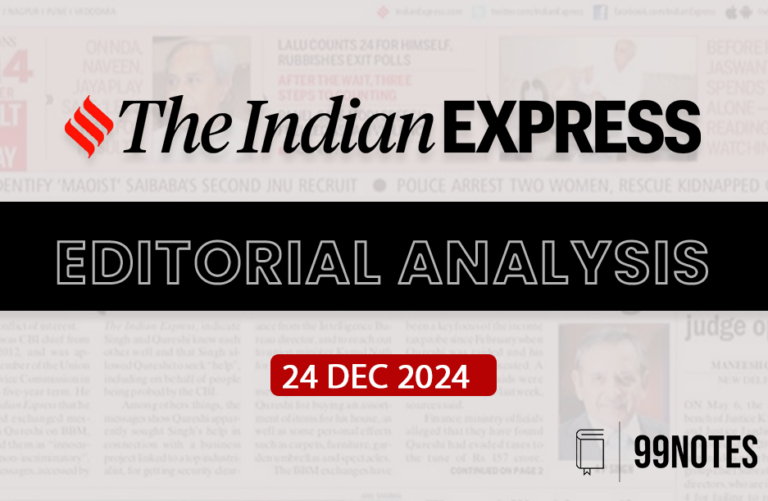22 November 2024 : Daily Current Affairs
1. Global Alliance Against Hunger and Poverty Launched at G20 Summit: Aimed at Eradicating Hunger and Poverty by 2030
- 1. Global Alliance Against Hunger and Poverty Launched at G20 Summit: Aimed at Eradicating Hunger and Poverty by 2030
- 2. Is Delhi becoming an uninhabitable city?
- 3. ‘Global consensus must to face challenges in using AI for governance’
- 4. ‘AI will drive innovation, revolutionise business and make life better’
- Prelims Facts
- 1. Dr. Jitendra Singh Launches VISION Portal, for nurturing skill development in underprivileged children
- 2. Charaideo Maidam’s World Heritage Site Status Draws Global Travellers to Assam & Ahom Heritage
- 3. COP29 Deadlock: Study Highlights Massive Economic Returns for Developed Nations Through Climate Finance Investments
- 4. ICC issues arrest warrants against Netanyahu, Gallant, and Hamas leaders
- 5. Rock-cut footprints, human figure dating back to Megalithic period unearthed at Kerala’s Kanhirapoil
(Source: Indian Express; Section: Explained; Page: 11)
| Topic: GS2 – Social Justice |
| Context: |
| The article discusses the launch of the Global Alliance Against Hunger and Poverty at the G20 Summit, highlighting its mission to eliminate global hunger and poverty by 2030 through coordinated international efforts. |
Analysis of News:
Launch of the Global Alliance Against Hunger and Poverty
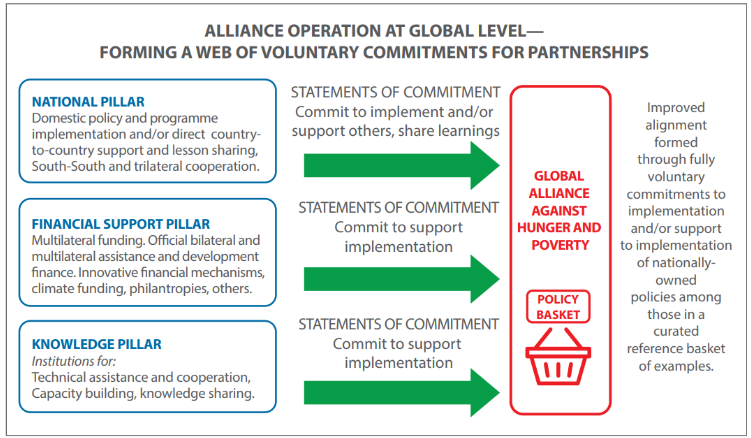
- The Global Alliance Against Hunger and Poverty was launched at the G20 Leaders’ Summit in Rio de Janeiro to fast-track the eradication of hunger and poverty.
- With 148 members, including nations, organizations, and financial institutions, it aims to eliminate countries from the FAO’s hunger map by 2030.
- The Alliance is built on three pillars: public policy coordination, data-driven solutions, and large-scale resource mobilization, and has set ambitious goals such as expanding school meals and reaching 500 million people with income distribution programs.
Current Global Hunger and Poverty Challenges
- The 2024 Global Hunger Index (GHI) reveals alarming hunger levels in 42 countries, with India ranking 105th out of 127 nations. India’s GHI score of 27.3 reflects serious hunger, worsened by undernourishment, child stunting, and wasting.
- Similarly, the Global Multidimensional Poverty Index (MPI) highlights that 234 million Indians live in extreme poverty, contributing to the 1.1 billion people globally facing acute poverty, making SDG-1 (ending poverty) a significant challenge.
What are India’s Progress on Hunger and Poverty Alleviation?
- Poverty Alleviation: Between 2014-2024, India lifted 250 million people out of poverty.
- Food Security: Over 800 million people are being given food grains free of cost.
- Health Insurance: 550 million people are benefiting from the Ayushman Bharat-Pradhan Mantri Jan Arogya Yojna (PM-JAY).
- 60 million senior citizens, over the age of 70, will also be able to benefit from free health insurance.
- Financial and Social Inclusion: Over 300 million women micro-entrepreneurs have been linked to banks and given access to credit.
- Farmer Support: Under Pradhan Mantri Fasal Bima Yojana (PMFBY), over 40 million farmers have received benefits worth 20 billion US dollars.
- Under PM-KISAN, assistance worth over 40 billion dollars has been given to 110 million farmers.
- India has developed over 2000 climate-resilient crop varieties.
- Nutritional Focus: The Saksham Anganwadi and Poshan 2.0 campaign focuses on nutrition for pregnant women, newborn babies, children under the age of 6, and adolescent girls.
- Through the Mid Day Meal scheme, special attention is being paid to the nutritional needs of school-going children.
- Global Contributions to Food Security: Recently, India has provided humanitarian assistance to Malawi, Zambia and Zimbabwe.
Lessons from the Global Hunger and Poverty Indices
- The GHI and MPI emphasize the multidimensional nature of hunger and poverty, calling for integrated approaches across health, education, and living standards.
- India’s poorer performance compared to neighbors like Bangladesh and Sri Lanka signals the need for targeted interventions.
- The Alliance’s focus on innovative programs, financial support, and evidence-based policymaking offers a pathway to align efforts with SDGs 1 and 2 (Zero Hunger).
The Role of the G20 and International Cooperation
- The G20, representing 85% of global GDP, is crucial in addressing these challenges. With the African Union recently joining as a member, the G20 expands its focus on inclusivity and global equity.
- Through mechanisms like the rotating presidency and support from the troika, the G20 provides a collaborative platform to promote sustainable solutions, such as the Global Alliance, which underscores the importance of multilateral efforts in eradicating hunger and poverty.
The Way Forward
- To meet the 2030 targets, effective implementation of strategic commitments, strong international collaboration, and leveraging platforms like the Global Alliance and G20 are essential.
- Tackling systemic issues like administrative inefficiencies and resource mobilization will be pivotal in achieving meaningful progress in hunger and poverty eradication.
| What is the Need for the Global Alliance Against Hunger and Poverty? |
|
Escalating Poverty and Hunger: In 2022, approximately 712 million people lived in extreme poverty—23 million more than in 2019—with the highest rates in the poorest countries. In 2023, 733 million people faced hunger, and 148 million children under five suffered from stunting (low height-for-age). Increasing Financing Gaps: The widening gaps in financing for achieving Sustainable Development Goals (SDGs), particularly SDGs 1 (no poverty) and 2 (zero hunger), highlight the urgent need for additional resource mobilisation. A global alliance can bridge the resource gap with innovative financing, international cooperation, and equitable resource allocation. Gender-Based Food Insecurity: 26.7% of women worldwide were food insecure, compared to 25.4% of men, showing a gender gap worldwide. Insufficient Responses: Ineffective policies, inadequate social protection, and limited resources continue to worsen hunger and malnutrition, leaving vulnerable populations without sufficient means to access adequate food and healthy diets. Economic Impact of Poverty: Poverty, hunger, and malnutrition impose major economic costs on households, health systems, and national economies, particularly in developing countries. This cycle lowers productivity, hampers sustainable growth, and deepens social and economic inequalities. Crisis Among Vulnerable: Rising acute food insecurity, humanitarian crises, and fragile states call for improved crisis prevention, preparedness, and resilience. A global alliance can enable targeted investments and coordinated responses to protect vulnerable populations. |
|
PYQ: Which of the following is/are the indicators/indicators used by IFPRI to compute the Global Hunger Index Report? (2016) 1. Undernourishment 2. Child stunting 3. Child mortality Select the correct answer using the code given below: (a) 1 only (b) 2 and 3 only (c) 1, 2 and 3 (d) 1 and 3 only Ans: (c) |
| Practice Question: Discuss the significance of the Global Alliance Against Hunger and Poverty in addressing global hunger and poverty challenges. How can such multilateral initiatives contribute to achieving Sustainable Development Goals by 2030? (250 words/15 m) |
2. Is Delhi becoming an uninhabitable city?
(Source – The Hindu, International Edition – Page No. – 12)
| Context |
|
Delhi’s Air Quality: A Growing Concern
- Delhi is on the verge of becoming an uninhabitable city, primarily due to severe air pollution in winter and extreme heat waves in summer. These conditions disproportionately affect the city’s poorer population.
- In winter (October-February), pollution levels peak, with PM2.5 playing a dominant role in the AQI readings.
- PM2.5 particles are hazardous due to their microscopic size, making them more dangerous as they can reach the deeper parts of the lungs.
| Air Quality Index (AQI) and its Significance |
|
The Air Quality Index (AQI) measures the concentration of pollutants in the air, including PM10, PM2.5, nitrogen dioxide (NO2), sulphur dioxide (SO2), carbon monoxide (CO), ozone (O3), ammonia (NH3), and lead (Pb). Each pollutant is assigned a sub-index, and the worst sub-index determines the overall AQI for a location, helping to simplify complex air quality data into an understandable index. Trends in Delhi’s Air Quality (2017-2023) Over the past seven years (2017-2023), Delhi has recorded only two days of healthy air per year. More than half of the year, residents breathe air deemed unfit for health. Even during the 2020 lockdown, when human activity reduced, the air quality barely improved, suggesting systemic issues beyond temporary reductions in emissions. |
Stubble Burning vs. Other Pollutants
- The government often blames stubble burning in neighboring states for Delhi’s pollution, but this is only part of the problem.
- Stubble burning contributes 15-35% to PM2.5 levels, but even on peak pollution days, Delhi’s air quality would remain very poor without stubble burning.
- The government uses stubble burning as a scapegoat to avoid addressing systemic causes of pollution.
Internal Pollution Sources in Delhi
- A 2023 report revealed that half of the PM2.5 pollution in Delhi during winter comes from internal sources.
- Vehicles contribute 58% of this pollution, with 34% from exhaust and 24% from tire and brake wear.
- The need for a shift from private vehicles to public transport running on cleaner energy is emphasised as a solution.

Winter Pollution and Meteorological Factors
- During the winter months, cold air traps pollutants close to the ground, worsening air quality. Low wind speed and lack of rainfall further contribute to the concentration of pollutants in Delhi’s air.
Health Impact of Air Pollution
- Air pollution impacts almost every organ in the body and can lead to systemic inflammation and even cancer.
- In 2019, 1.67 million deaths in India were attributed to pollution, with PM pollution being a major contributor.
- Delhi’s death rate from ambient PM pollution is significantly higher than the national average, underlining the health risks posed by prolonged exposure to pollutants.

Class-Based Disparities in Exposure
- Poor children in Delhi experience significantly higher exposure to PM2.5 compared to wealthier children, with this exposure potentially reducing their life expectancy by up to five years.
Political and Administrative Response
- The political response to Delhi’s air pollution remains insufficient, with stopgap measures like odd-even traffic rules, engine-off policies, and mask distribution failing to address the root causes.
- Both the Delhi and central governments have been criticised for lacking political will to implement long-term solutions to the pollution crisis.
Conclusion
- Delhi’s air quality crisis is a complex issue requiring systemic changes in transportation, energy policies, and governance.
- Effective solutions demand strong political action and public cooperation, going beyond short-term, media-driven measures.
| PYQ: Mumbai, Delhi and Kolkata are the three megacities of the country but the air pollution is a much more serious problem in Delhi as compared to the other two. Why is this so? (200 words/12.5m) (UPSC CSE (M) GS-1 2015) |
| Practice Question: Discuss the major factors contributing to air pollution in Delhi and evaluate the effectiveness of government policies in addressing this issue. What systemic changes are required to mitigate Delhi’s air quality crisis? (250 Words /15 marks) |
3. ‘Global consensus must to face challenges in using AI for governance’
(Source – The Hindu, International Edition – Page No. – 4)
| Context |
|
Global Consensus on AI Regulations
- At the AI Summit 2024 panellists emphasised the need for a global consensus on regulating Artificial Intelligence (AI) to address challenges such as copyright issues, data protection, and cyber vulnerabilities.
- Expanding AI’s application into newer areas of governance was a recurring theme during the discussions.
AI in Governance: Health Sector Applications
- AI has been effectively implemented in diagnosing tuberculosis, improving detection rates twofold compared to traditional methods.
- AI tools in mobile X-ray vans screened over 56,000 people, showcasing the technology’s precision in healthcare diagnostics.
- Potential applications include screening for refractive eye errors in children and detecting pregnancy-induced hypertension (PIH).
AI for Wildlife Conservation
- AI solutions are being used to prevent elephant deaths on railway tracks in forested regions, mitigating human-wildlife conflict effectively.
- These initiatives highlight AI’s versatility in addressing complex challenges across diverse sectors.
Infrastructure and Contextual Safeguards
- The success of AI in governance depends on building robust digital infrastructure.
- Experts stressed the importance of creating AI models tailored to India’s unique cultural and regional diversity, including language, cuisine, and literature.
- A proposed AI safety institute by the Union government aims to ensure secure and ethical AI deployment.
Risks and Ethical Concerns
- AI presents challenges like bias, fairness, and risks exacerbated by generative AI, including issues of copyright, data protection, and cyber vulnerabilities.
- Safeguards are necessary to prevent misuse and to protect sensitive data, ensuring data localisation to avoid dependency on foreign entities.
India’s Role in Global AI Development
- India is positioned as a potential global leader in AI technologies alongside the U.S. and China.
- India should transition from being a consumer of AI to becoming a generator of AI technologies.
- Digitisation in governance is yielding efficiency gains, but data localisation and ethical frameworks are critical to achieving sustainable progress.
Way Forward
- AI should be deployed selectively, ensuring it addresses governance challenges effectively.
- Global collaboration and regulatory frameworks are essential for addressing emerging challenges while capitalising on AI’s transformative potential.
| PYQ: Introduce the concept of Artificial Intelligence (AI). How does AI help clinical diagnosis? Do you perceive any threat to privacy of the individual in the use of Al in healthcare? (150 words/10m) (UPSC CSE (M) GS-3 2023) |
| Practice Question: Discuss the role of Artificial Intelligence in governance, highlighting its applications, challenges, and ethical considerations. How can India leverage its potential to become a global leader in AI technologies? (250 Words /15 marks) |
4. ‘AI will drive innovation, revolutionise business and make life better’
(Source – The Hindu, International Edition – Page No. – 5)
| Topic: GS3 – Science and Technology |
| Context |
|
The Hindu AI Summit 2024 highlighted Artificial Intelligence’s transformative impact on business operations, sustainability, and job markets. Experts emphasised leveraging AI to optimise processes, enhance productivity, and integrate modern systems, while addressing workforce concerns and legacy challenges. |
AI’s Role in Driving Business Innovation
- Artificial Intelligence (AI) is set to revolutionise business operations, delivering innovative and efficient solutions.
- Businesses can leverage AI to enhance operational efficiency and drive innovation across key functions.
- A focus on three pillars—people, process, and technology—is essential for integrating AI effectively.
Transitioning from Legacy Systems
- Industries must identify bottlenecks in their processes and optimize existing systems.
- Migration from legacy systems to digital platforms is critical for achieving innovation.
- Digital transformation requires iterative implementation and careful planning, not just replacing old technologies with new ones.
Contribution to Sustainability Goals
- AI-powered solutions can optimise energy usage and reduce waste in business operations.
- Metrics-based approaches help optimise processes and leverage technology for sustainable practices.
Enhancing Business Models
- AI enables companies to rethink traditional models, fostering greater confidence and efficiency.
- Successful implementation of AI requires organisations to align goals and investment with their digital-first ambitions.
Impact on Jobs and Workforce Efficiency
- AI complements human intelligence, enabling coexistence while enhancing employee efficiency.
- It drives cost savings and improves processes by handling massive data and solving complex problems.
- Far from replacing jobs, AI creates new opportunities and increases workforce productivity.
Measuring Success of AI Initiatives
- Key performance indicators for AI success include improved business optimization, financial metrics, customer engagement, and sustainability goals.
- AI reduces the cost of hyper-personalised customer services, enabling better outcomes with fewer resources.
Breaking the Legacy Mindset
- Legacy systems no longer pose barriers, as modern systems can manage structured and unstructured data effectively.
- Adopting AI requires breaking the traditional mindset and prioritizing motivation for digital transformation.
| Practice Question: Discuss the role of Artificial Intelligence in transforming business operations and achieving sustainability goals. How can India ensure equitable access to AI-driven opportunities while addressing workforce challenges? (150 Words /10 marks) |
Prelims Facts
1. Dr. Jitendra Singh Launches VISION Portal, for nurturing skill development in underprivileged children
(Source – https://pib.gov.in/PressReleseDetail.aspx?PRID=2075532®=3&lang=1 )
| Context |
| The VISION initiative aims to democratise startup skills and innovation opportunities for underprivileged youth across India, fostering education and entrepreneurship.It aligns with India’s broader goals of technological leadership and inclusive economic growth under Vision India 2047. |
Information about the VISION Portal
- Objective: Aimed at nurturing education, skill development, and innovation among underprivileged children.
- Ministry: Operates under the Ministry of Science & Technology
- Focus: Democratizes access to startup skills and opportunities for students across India, including remote areas.
- Features: Provides mentorship, training, and resources for aspiring innovators and entrepreneurs.
- Inclusivity: Enables underprivileged youth to participate in the startup ecosystem and experience advancements in education and technology.
- Technology Bridging Gaps: Acts as a platform for students in rural areas to leverage technology for educational and professional growth.
- Role in Vision India 2047: Integral to India’s goals of becoming a global leader in technology, education, and economic development.
- Support: Promotes public-private partnerships and early industry linkages for sustainability.
2. Charaideo Maidam’s World Heritage Site Status Draws Global Travellers to Assam & Ahom Heritage
(Source – https://pib.gov.in/PressReleseDetail.aspx?PRID=2075583®=3&lang=1 )
| Context |
| The Charaideo Maidam, a testament to the Ahom dynasty’s architectural brilliance and cultural legacy, has been recognized as a UNESCO World Heritage Site, the first cultural site from Northeast India to receive this honour.The recognition highlights years of dedicated efforts led by the government.The milestone celebrates Assam’s rich history, inviting global attention to its heritage and cultural traditions. |
Charaideo Maidam:
- Location: Situated in Assam, India, Charaideo was the original capital of the Ahom Kingdom established in the 13th century.
- Historical Significance: Known as the “Pyramids of Assam,” it served as the burial site for Ahom kings and queens, symbolising their architectural ingenuity and spiritual beliefs.
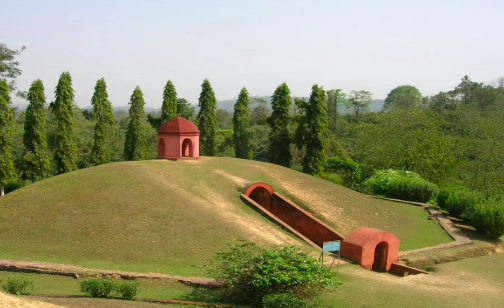
- Cultural Importance: The Maidams are sacred burial mounds that reflect the Ahom dynasty’s unique blend of Tai culture and indigenous traditions.
- Architectural Features: The mounds exhibit an intricate design blending domed structures with earthen layers, showcasing advanced construction techniques of the time.
- UNESCO Recognition: Declared a World Heritage Site in 2024, highlighting its global cultural and historical value.
- Legacy: Represents the ideals of harmony and governance introduced by Ahom rulers like Chaolung Sukapha.
3. COP29 Deadlock: Study Highlights Massive Economic Returns for Developed Nations Through Climate Finance Investments
(Source: Indian Express; Section: Govt & Politics; Page: 07)
| Context: |
| The ongoing COP29 summit in Baku has witnessed a continued deadlock on climate finance negotiations, with developing countries demanding $1.3 trillion annually to address climate challenges. A new study from Cornell University highlights the economic and moral imperatives for developed nations to meet these demands, emphasizing the potential for significant economic returns. |
Analysis of News:
What is COP 29?
- COP 29, also known as the United Nations Climate Change Conference, is an annual summit under the UNFCCC. These conferences serve as the principal forum for countries to discuss and make decisions on combating climate change.
- Initiated in 1995, COP meetings have been instrumental in shaping international climate policies like the Kyoto Protocol and the Paris Agreement.
- At COP 29, nations will aim to strengthen global commitments to limit global warming to 1.5°C, address the escalating impacts of climate change, and promote sustainable development.
COP 29 Summit Key Theme
- The theme for COP 29 focuses on accelerating actions to achieve climate goals through innovative solutions, increased financial support, and equitable partnerships.
- The 2024 United Nations Climate Change Conference (UNFCCC COP 29) is titled “Investing in a livable planet for all” and currently held at the Baku Olympic Stadium in Azerbaijan.
Economic Returns on Climate Mitigation Investments
- According to the study, financing mitigation efforts in developing countries offers substantial returns.
- Developed nations would need to contribute $2.8 trillion in public finance by 2035 to mobilize the required $10.5 trillion for mitigation.
- This investment could yield global economic returns of $5 to $41 trillion over a decade, translating to a return on investment (ROI) of 180% to 1457%.
- These benefits stem primarily from avoided CO2 emissions, which provide country-specific advantages to developed nations.
Climate Finance: A Moral and Strategic Necessity
- Under the Paris Agreement, developed countries have a moral obligation to assist developing nations in climate mitigation.
- Beyond morality, the study underscores the economic self-interest for developed nations, as financing these efforts would result in a net economic benefit of $5.1 to $40 trillion between 2025 and 2035.
- This dual benefit strengthens the case for fulfilling climate finance commitments.
4. ICC issues arrest warrants against Netanyahu, Gallant, and Hamas leaders
(Source – The Hindu, International Edition – Page No. – 1)
| Context |
| The International Criminal Court issued arrest warrants against Israeli Prime Minister Benjamin Netanyahu, his former Defence Minister Yoav Gallant and Hamas officials – accusing them of war crimes and crimes against humanity linked to the Gaza conflict.Israel and the U.S., non-members of the ICC, rejected the charges, complicating ceasefire negotiations.The decision spotlights alleged humanitarian violations during the ongoing hostilities. |
More About International Criminal Court:
- Established: 2002 under the Rome Statute.
- Headquarters: The Hague, Netherlands.
- Purpose: Prosecutes individuals for genocide, war crimes, crimes against humanity, and aggression.
- Membership: 124 states; notable non-members include the U.S., Russia, China, Israel and India.
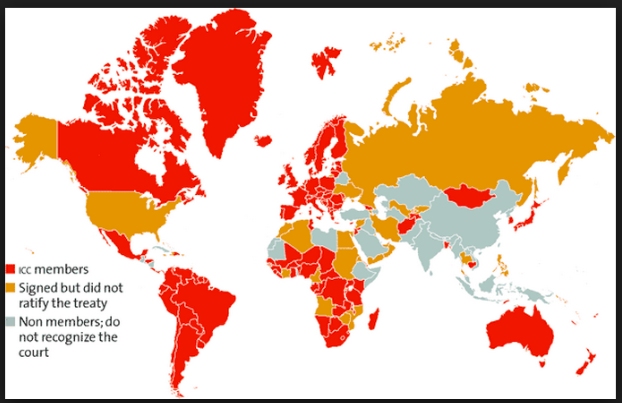
- Jurisdiction: Cases referred by member states, UN Security Council, or ICC Prosecutor.
- Independent: Not part of the United Nations system.
- Structure: Composed of the Presidency, Judicial Divisions, Office of the Prosecutor, and Registry.
- Criticism: Accused of bias against African nations; struggles with enforcement due to reliance on state cooperation.
- Notable Cases: Includes leaders like Sudan’s Omar al-Bashir and Uganda’s Joseph Kony.
5. Rock-cut footprints, human figure dating back to Megalithic period unearthed at Kerala’s Kanhirapoil
(Source – The Hindu, International Edition – Page No. – 3)
| Context |
| A significant prehistoric discovery has been made at Kanhirapoil in Kerala, uncovering 24 pairs of footprints and a human figure carved into rock, likely from the Megalithic period.Experts suggest these carvings honour the dead, offering cultural insights.The site bears similarities to other prehistoric rock art in South India. |
Analysis of the news:
- Location: Kanhirapoil in Madikkai grama panchayat, Kerala.
- Discovery: 24 pairs of prehistoric footprints and a human figure carved into rock.
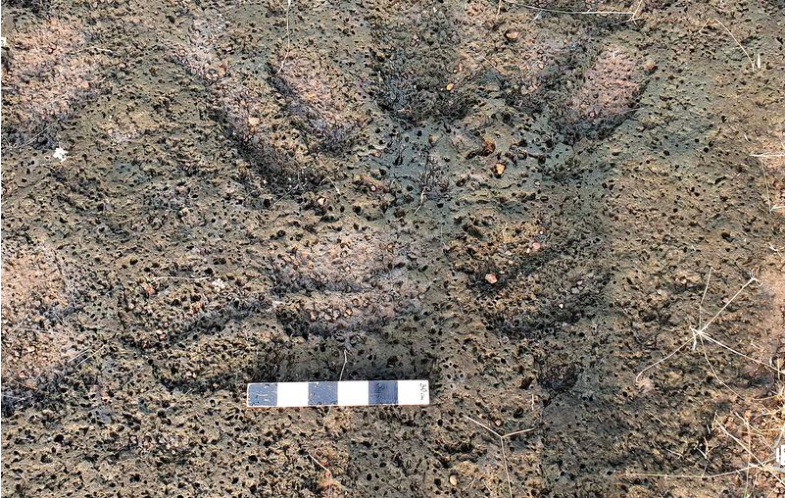
- Dating: Believed to date back to the Megalithic period (~2,000 years old).
- Reported by: Satheesan Kaliyanam, confirmed by archaeologist Prof. Ajith Kumar and historian Prof. Nandakumar Koroth.
- Features: Footprints (6-10 inches) represent children and adults, pointing west; accompanied by a human figure and four circular pits.
- Significance: Likely carved to honour souls of the dead; local belief attributes the footprints to a goddess.
- Similarity: Comparable to prehistoric rock art in Udupi (Karnataka) and sites in north Kerala like Edakkal Caves.
- Insight: Highlights the artistic and cultural heritage of ancient Kerala.


